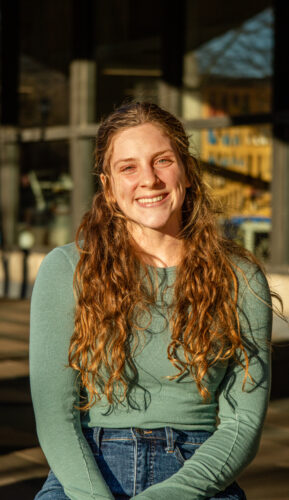Image Courtesy of Daniel Havlat.
Grayson Wagner (YC ’23) knew from a young age that she wanted to be an engineer. She grew up admiring her father’s work as an industrial engineer, and by her junior year of high school, she had decided on biomedical engineering. Wary that many students switch majors during college, Wagner wasn’t sure if she would stick with it. However, she has delved deeply into the realm of biomedical engineering, while adding a second major in mechanical engineering.
In 2020, Grayson founded Yale’s inaugural e-NABLE chapter—a volunteer group that uses 3D printing to construct upper-limb prostheses for those in need. The e-NABLE club allows Wagner to use her two majors for a humanitarian purpose. She established the chapter with the help of Vincent Wilczynski, the Deputy Dean of the School of Engineering and Applied Sciences. She originally learned about the organization during her senior year of high school and wanted to bring it to Yale. “I’ve shadowed at a lot of clinics, [and] I’ve seen a lot of patients. I’ve gotten that experience, and it’s a really interesting field. A lot of people don’t know about [prosthetics], about the fabrication, the assembly, and the difference it can make for people,” Wagner said.
The e-NABLE club began work soon after its founding. The group received a request from a father hoping for a prosthetic arm that his daughter, Emily, could use to hold her bow while playing the cello. When starting projects, the group consults a database that contains about twenty basic prosthetic designs, including ones for upper-limb prostheses beginning at the wrist, elbow, shoulder, and even fingers. The team can then download the design that is best suited for their goal and use computer-aided design software, such as SolidWorks or Onshape, to upload the design and make their changes. Once satisfied, the prototype can be 3D printed and assembled.
A notable aspect of designing prostheses in this manner is that the files for each design are transferable. Wagner explained that while Emily was filming a commercial in Arizona, her prosthesis broke mid-shoot, but e-NABLE design head Zubin Kremer Guha (YC ‘24) was able to send the files to Arizona where the device could be reprinted. Wagner loved working with Guha and the other design head for the project, Audrey Whitmer (YC ‘23). “It was exciting seeing two different passionate engineers come together and create one cohesive device for Emily. They did a fantastic job,” Wagner said.
The prostheses made by e-NABLE are not intended to replace traditional prostheses since the volunteers are not certified prosthetists or orthotists. However, as Emily’s story shows, there are many benefits to making specialized prosthetics that are not meant for everyday use. “You can make these really specific adaptive features that are harder to do and less accessible in a clinical setting,” Wagner said.
Wagner’s passion for biomedical engineering extends to her research with John Geibel, a professor of cellular and molecular physiology and vice chairman of the Department of Surgery at Yale. With Geibel, Wagner works on bioprinting, which uses similar techniques to 3D printing but relies on biomaterials such as living cells to build complex structures. Bioprinting has the potential to greatly impact the future of manufacturing bioengineered tissues and organs. Wagner, who has many interests within this field, published a review paper in Pharmaceutics in December 2022 on the use of hydrogels—networks of polymer chains with great capacity to hold water—in bioprinting, and she has recently submitted another review about bioprinting’s applications to bone tissue.
Wagner further shares her love for engineering as the president of Tau Beta Pi, the engineering honor society. She also enjoys connecting with friends outside of the engineering sphere as a member of the Yale Climbing Team.
For the rest of the semester, Wagner plans to savor her last moments with her biomedical engineering class, and she looks forward to continuing her work in tissue engineering and medical device design after graduation. “I’m excited to move on to my next phase, working with companies that are taking bioprinting and tissue engineering from the bench to the bedside,” Wagner said.

